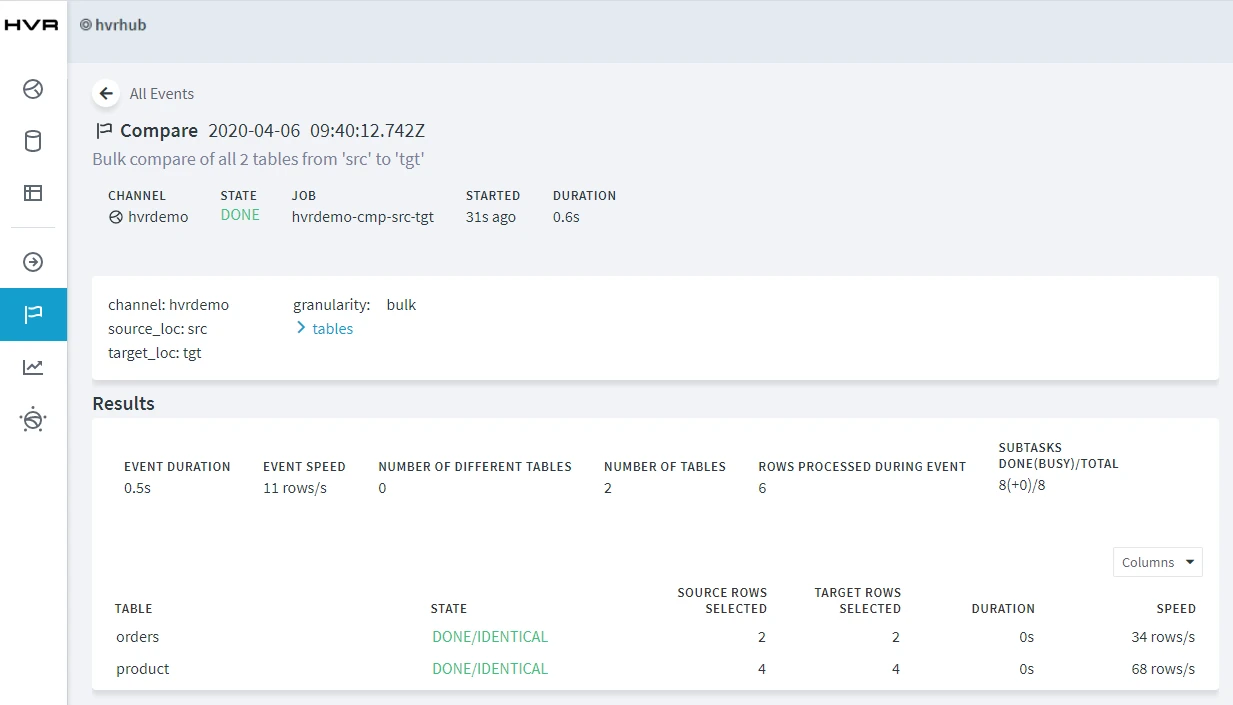Quick Start for HVR - HANA
This quick start guide helps you to get started with HVR for replicating data between SAP HANA databases.
To proceed with this replication you must have a basic understanding of HVR's architecture and terminology like Hub, Location, Channel, Location Groups, and Actions.
The example here demonstrates how to replicate tables from a HANA database on a source location to a HANA database on a target location. The HVR hub database will be located on an Oracle server because HVR does not support the hub database on HANA. In real-life scenarios, the source location(s) and the target location(s) reside on different machines and the HVR hub can reside on the source or target or a separate machine. In this demonstration, for simplicity, the source and target databases are on the same machine and the HVR hub will be located on a remote Oracle machine.
For the HVR hub to connect to the remote source and target locations, an HVR remote agent should be installed on the HANA server.
Before proceeding with this demonstration, ensure that the requirements for using HVR with HANA and Oracle are met.
For information about access privileges and advanced configuration changes required for performing replication using HANA and Oracle, see:
Create Demo Schemas and Tables
The initial steps of this demonstration are to create:
- a schema in the source location
- column-storage tables in the source schema (and insert values into these tables)
Source Location
Skip this section if you already have a database with tables that you plan to use for this replication.
For this demonstration, in the source location database (e.g. testdb), create a schema (e.g. sourcedb) and two tables (e.g. product and orders) and insert values into these tables.
Sample SQL statements to create schema and tables in source location, and also to insert values into these tables,
Create Schema in Source Location
Create source schema (sourcedb):
create schema sourcedb owned by hvruser;
HVR supports capturing only from column-storage tables in HANA. For this demonstration, create two column-storage tables called product and orders.Create Tables in Source Schema
create COLUMN table sourcedb.product ( prod_id number(10) not null, prod_price number(10,2) not null, prod_descrip varchar2(100) not null );
create COLUMN table sourcedb.orders ( prod_id number(10) not null, ord_id number(10) not null, cust_name varchar2(100) not null, cust_addr varchar2(100) );
Insert Values in Source Tables
insert into sourcedb.product values (100, 90, 'Book');
insert into sourcedb.orders values (100, 123, 'Customer1', 'P.O. Box 122, Anytown, Anycountry');
Target Location
HVR automatically creates tables in the target database during HVR Refresh, and it is the recommended method for creating tables in the target schema.
Create Hub Database
This section describes how to create a hub database (schema). The hub database is a repository database that HVR uses to control its replication activities. It contains HVR catalog tables that hold all specifications of replication such as the names of the replicated databases, the replication direction and the list of tables to be replicated. For more information about HVR hub server and database, see section Hub Server in System Requirements.
HVR supports the creation of a hub database on certain databases (location classes) only. For the list of supported location classes, see section Hub Database in Capabilities.
For this demonstration, the hub database (e.g. hvrhub) is created in Oracle.
Create the hub database (hvrhub) with password (hvr).
create user hvrhub identified by hvr default tablespace users temporary tablespace temp quota unlimited on users;
Grants/Access Privileges
This section describes the grants/access privileges required for the hub, source, and target databases.
Configure the privileges for the Oracle hub database (hvrhub). For more information, see section Grants for Hub Schema in Requirements for Oracle.
grant create session to hvrhub; grant create table to hvrhub; grant create procedure to hvrhub; grant create trigger to hvrhub; grant execute on dbms_alert to hvrhub;A user with dba privileges should grant execute on dbms_alert to the hub database user (e.g. hvruser).
Configure the privileges for the HANA source database (sourcedb). For more information, see section Grants for Capture in Requirements for HANA.
Grants for capture from HANA
The following grants are required for capturing changes from HANA:
To read from tables that are not owned by HVR User (using TableProperties/Schema), the User must be granted select privilege.
grant select on tbl to hvrusergrant select on tbl to hvruserThe User should also be granted select permission from some system table and views. In HANA, however, it is impossible to directly grant permissions on system objects to any user. Instead, special wrapper views should be created, and User should be granted read permission on this views. To do this:
Connect to the HANA database as user SYSTEM.
Create a schema called _HVR.
create schema _HVR;Grant SELECT privilege on this schema to User.
grant select on schema _HVR to hvruser;Execute the hvrhanaviews.sql script from the $HVR_HOME/sql/hana directory.
This will create a set of views that HVR uses to read from system dictionaries on HANA.
Configure the privileges for the HANA target database (targetdb). For more information, see section Grants for Integrate and Refresh Target in Requirements for HANA.
Grants for integrate into HANA
The following grants are required for integrating changes into HANA:
- The User should have permission to read and change replicated tables
grant select, insert, update, delete on tbl to hvruser
The User should have permission to create and alter tables in the target schema
grant create any, alter on schema schema to hvruserThe User should have permission to create and drop HVR state tables
- The User should have permission to read and change replicated tables
Download, Install, and Configure HVR
This section describes how to download HVR, install it on either Windows, Linux, or Unix machines, as well as configure an HVR remote agent for the HVR hub to connect to the remote source and target locations.
- Download and Install HVR
For this demonstration, an HVR distribution should be installed:
On the HANA machine. This will be an HVR Remote agent for capture and integrate. This HVR remote agent will establish a connection to the HANA database and the hub can connect to it via a running HVR remote listener.
If the source and target databases are on different machines, the HVR remote agent should be installed on both source and target location machines.
On the hub machine.
An HVR distribution is available for download at the fivetran.com website. For more information, see Downloading HVR.
Install HVR on a hub machine. For details on installing HVR, see the respective operating system sections:
The HVR distribution requires a license key in order for the software to operate. See the HVR licensing page for more details on how to install the HVR license.
- Configure HVR remote agent
After installing the HVR remote agent on the HANA machine, it needs to be configured to connect from the HVR hub. For the detailed configuration steps, see the following sections:
After the installation, you can control HVR using the HVR graphical user interface (HVR GUI).
- If the hub machine is Windows, then HVR GUI can be executed directly on the hub machine.
- To control HVR remotely from your PC, connect to the hub machine using Windows Remote Desktop Connection and launch HVR GUI on the hub machine.
- If the hub machine is Linux, then HVR GUI can be executed directly on the hub machine. However, an application like X Server or VNC viewer must be installed to run HVR GUI directly on Linux.
- To control HVR remotely from your PC, install HVR on the PC (with Windows or macOS) and configure the HVR Remote Listener on the hub machine.
- If the hub machine is Unix, then HVR GUI should typically be run remotely from a PC to control HVR installed on the hub machine. To do this, install HVR on the PC (with Windows or macOS) and configure the HVR Remote Listener on the hub machine.
The HVR Remote Listener allows you to connect HVR GUI available on your PC to the remote HVR hub machine.
Launch HVR GUI
This section describes how to launch HVR GUI on various operating systems.
On Windows and macOS, double-click the HVR shortcut icon available on the desktop or execute command hvrgui in the CLI.
On Linux, double-click the hvrgui file available in the HVR_extracted_path/bin directory or execute command hvrgui in the CLI.
Linux requires applications like X server or VNC viewer to execute HVR GUI.
On Unix, HVR GUI is not supported. So, HVR GUI should be run on a remote PC (with Windows, Linux, or macOS) to control HVR installed on the Unix machine.
Register Hub
This section describes how to connect HVR GUI to the hub database.
When you launch HVR GUI for the first time, the Register Hub dialog is displayed automatically. The Register Hub dialog can also be accessed from menu File by selecting Register Hub. Skip steps 1 to 4 if you want to run HVR GUI directly on the hub machine.
Click Connect to HVR on remote machine.
To connect HVR GUI on a PC to a remote HVR hub machine, the HVR Remote Listener must be configured and running on the HVR hub machine.
Enter the name or IP address of the hub machine in the Node field (e.g. myserver).
Enter the port number (defined in the HVR Remote Listener of the hub machine) in the Port field (e.g. 4343).
Enter the Login (e.g. myserveradmin) and Password for the hub machine. By default, this is the operating system login credentials of the hub machine.
Select Oracle in the Class pane.
Specify Database Connection details.
- Enter the directory path in ORACLE_HOME. You can also click the browse button to select the directory path.
- Enter the Oracle System ID in ORACLE_SID or TNS credentials.
- Enter the user name of the hub database in User (e.g. hvrhub).
- Enter the password for the hub database in Password (e.g. hvr).
Click Connect.

Click Yes in the prompt dialog asking to create catalog tables in the hub database.
HVR displays this prompt when connecting to a hub database for the first time.
On connecting successfully to the hub database, the navigation tree pane displays the hub machine and the hub database. Location Configuration, Channel Definitions, and Scheduler are displayed under the hub database.
Create Locations
This section describes how to create locations in HVR GUI. Location is a storage place (for example, database or file storage) from where HVR captures (source location) or integrates (target location) changes.
- Create one source location connected to the source schema (sourcedb).
- In navigation tree pane, right-click Location Configuration ▶ New Location.
- Enter Location name (e.g. src) and Description for the location.
- Click Connect to HVR on remote machine, because HVR needs to connect to the HVR remote agent installed. Enter the details of the virtual machine running the HVR Remote Agent there (in our example, the HVR Remote Agent runs on the same machine as the HANA server).
Enter the name or IP address of the HVR remote agent machine in the Node field (e.g. myserver).
Enter the port number (defined in the HVR Remote Listener of the HVR remote agentmachine) in the Port field (e.g. 4343).
Enter the Login (e.g. hvr) and Password for the HVR remote agent machine. By default, this is the operating system login credentials of the HVR remote agent machine.
The HVR agent on the HANA server needs to run an HVR Remote Listener on port 4343 for this connection to work.
- Select HANA in Class.
- Provide Database Connection details. For more information on Database Connection fields, see section Location Connection.
Enter the hostname or ip-address of the HANA server in Node.
Select the Mode as Multiple containers - Tenant database.
Enter the database Instance Number.
Enter the specific name of the Database in a multiple-container environment. For example, sourcedb.
Enter the username for Database in User.
Enter the password for User in Password.
- Click Test Connection to verify the connection to location database.
- Click OK.
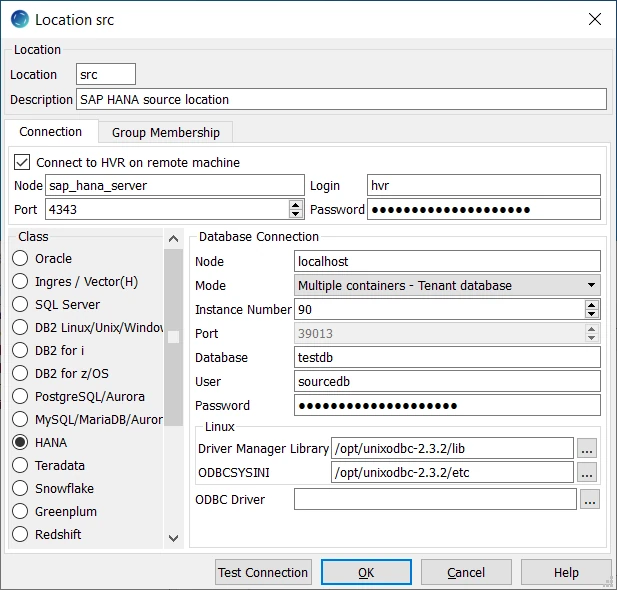
- Create one target location connected to the target schema (targetdb).
- In the navigation tree pane, right-click Location Configuration ▶ New Location.
- Enter Location name (e.g. tgt) and Description for the location.
- Click Connect to HVR on remote machine, because HVR needs to connect to the HVR remote agent installed. Enter the details of the virtual machine running the HVR Remote Agent there (in our example, the HVR remote agent runs on the same machine as the HANA server).
Enter the name or IP address of the HVR remote agent machine in the Node field (e.g. myserver).
Enter the port number (defined in the HVR Remote Listener of the HVR remote agent machine) in the Port field (e.g. 4343).
Enter the Login (e.g. hvr) and Password for the HVR remote agent machine. By default, this is the operating system login credentials of the HVR remote agent machine.
The HVR agent on the HANA server needs to run an HVR Remote Listener on port 4343 for this connection to work.
- Select HANA in Class.
- Provide Database Connection details. For more information on Database Connection fields, see section Location Connection.
Enter the hostname or ip-address of the HANA server in Node.
Select the Mode as Multiple containers - Tenant database.
Enter the database Instance Number.
Enter the specific name of the Database in a multiple-container environment. For example, targetdb.
Enter the username for the Database in User.
Enter the password for the User in Password.
- HVR only supports capture from HANA on Linux. For a default installation of the ODBC Driver Manager Library, HVR will automatically determine the default path to the library and the odbc.ini and odbcinst.ini files. Otherwise, the directories must be specified in the Driver Manager Library and ODBCSYSINI fields. For more information on Linux fields, see section Location Connection.
- Click Test Connection to verify the connection to location database.
- Click OK.
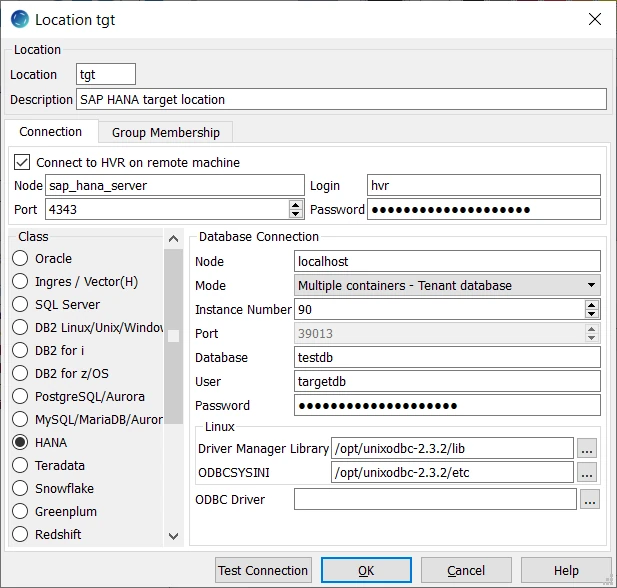
Create Channel
This section describes how to create a channel (e.g. hvrdemo) in HVR. A channel groups together the locations and tables that are involved in the replication. It also contains actions that control the replication.
- In the navigation tree pane, right-click Channel Definitions ▶ New Channel.
- In the New Channel dialog, enter Channel name and Description for the channel.
- Click OK.
Create Location Groups
This section describes how to create location groups in a channel. The location groups are used for defining actions on the location. Typically, a channel contains two location groups - one for the source location and one for the target location. Each location group can contain multiple locations.
For this demonstration, create one source location group (e.g. SRCGRP) and one target location group (e.g. TGTGRP).
- In the navigation tree pane, click + next to the channel (hvrdemo).
- Create source location group (SRCGRP):
- Right-click Location Groups ▶ New Group.
- Enter Group Name and Description for the location group.
- Select source location (src) in Group Membership. Click OK.
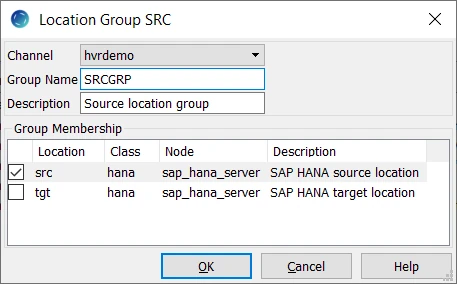
- Create target location group (TGTGRP):
- Right-click Location Groups ▶ New Group.
- Enter Group Name and Description for the location group.
- Select target location (tgt) in Group Membership. Click OK.
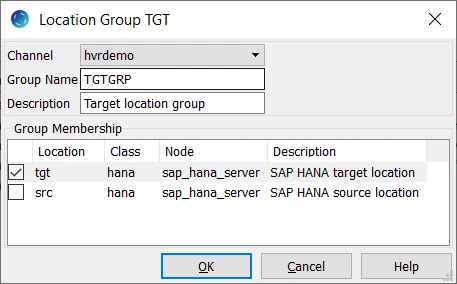
Define Actions
This section describes how to define actions on the location groups (SRCGRP and TGTGRP). Actions define the behavior of a replication activity.
Define action Capture to capture changes from all tables in the source location group.
Right-click source location group SRCGRP ▶ New Action ▶ Capture. Click OK.
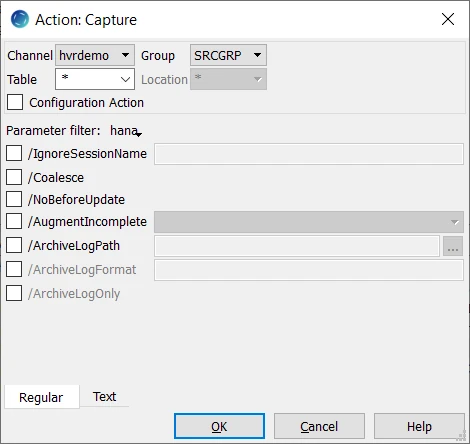
Define action Integrate to integrate changes into all tables in the target location group.
Right-click target location group TGTGRP ▶ New Action ▶ Integrate. Click OK.
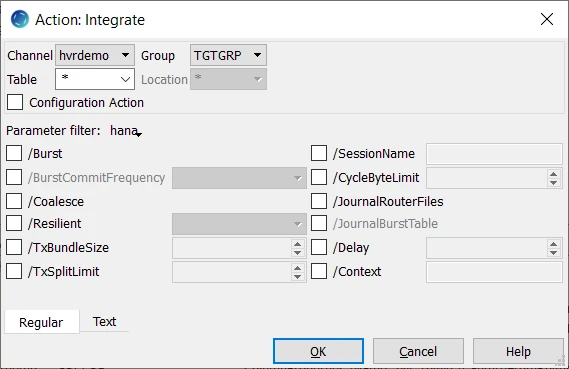
For a HANA location, HVR requires a temporary staging directory to store replicated data before loading it to a tartget database. Therefore, on both source (SRCGRP) and target (TGTGRP) location groups, define action LocationProperties with parameters /StagingDirectoryHvr and /StagingDirectoryDb to specify the directories for loading staging files:
/StagingDirectoryHvr is the location where HVR will create the temporary staging files, this should be the directory on the machine, from which HVR connects to HANA.
/StagingDirectoryDb is a local directory on the HANA machine which is configured for importing data by HANA.

Since is not possible to enable 'supplemental logging' on HANA, the real key values are not available to HVR during capture. Therefore, the following actions must be defined prior to adding tables to the channel to instruct HVR to capture Row ID values and use them instead of the regular keys during replication. On the source location group (SRCGRP), define action ColumnProperties with parameters /Name and /CaptureFromRowId.On both source (SRCGRP) and target (TGTGRP) location groups, define action ColumnProperties with parameters /Name and /SurrogateKey.
Right-click source location group SRCGRP ▶ New Action ▶ ColumnProperties.
Select parameter /Name. This parameter defines the name for the extra column in the souce location. Enter hvr_rowid.
Select parameter CaptureFromRowId. It instructs HVR to capture values from HANA tables' row-id column.
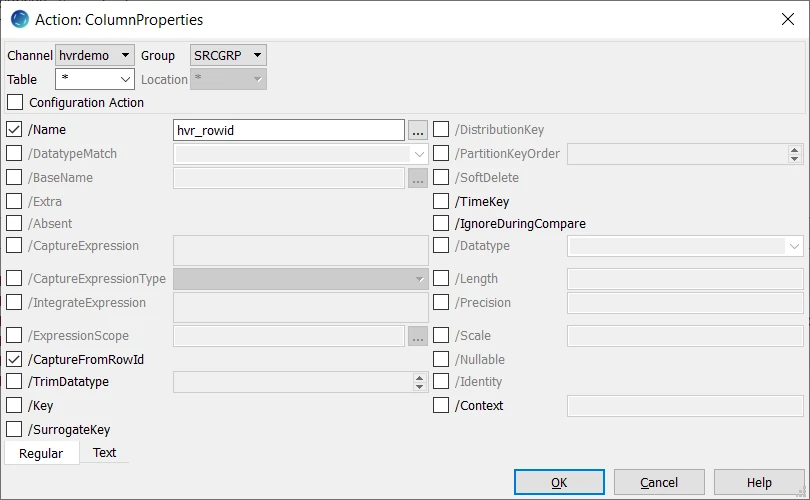
Right-click channel hvrdemo ▶ New Action ▶ ColumnProperties.
Select parameter /Name. This parameter defines the name for the extra column in the target location. Enter hvr_rowid.
Select parameter /SurrogateKey. It instructs HVR to use column hvr_rowid instead of the regular key during replication.
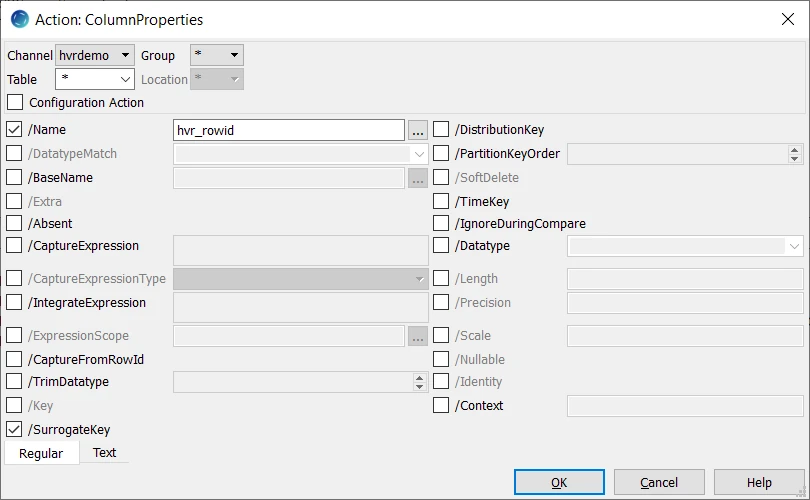
For the source (SRCGRP) and target (TGTGRP)location groups, define action Environment to use the Unix ODBC Driver Manager Library for connecting to HANA:
Right-click channel hvrdemo ▶ New Action ▶ Environment.
Select parameter /Name and specify the name of the environment variable HVR_ODBC_DM_LIB.
Select parameter /Value.This parameter defines a directory where the driver is installed. Select the directory using the browse button.
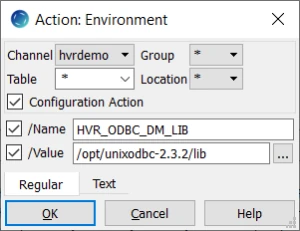
Select Table(s)
This section describes how to select the tables (product and orders) from the source location for replication. The Table Explore dialog allows you to select schema(s) and/or table(s) for replication.
- Right-click Tables ▶ Table Explore.
- Select source location (src) from the list.
- Click Connect.
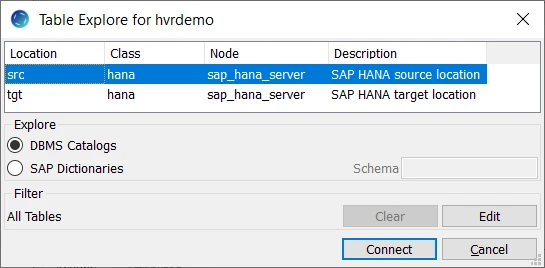
- Select tables from the Table Explore dialog. Use the Shift or Ctrl key to select multiple tables or Ctrl+A to select all tables.
- Click Add to add the selected tables to the channel.
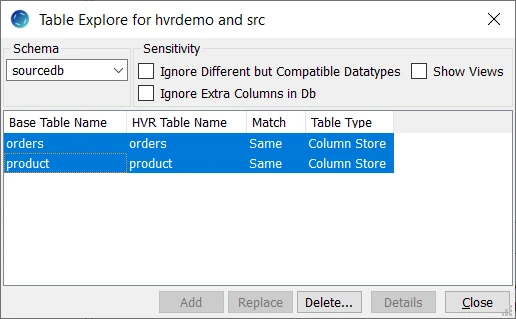
- Click OK in HVR Table Name dialog.
- Click Close in Table Explore dialog.
Initialize
This section describes how to initialize the replication. HVR Initialize first checks the channel and creates the replication jobs in the HVR Scheduler.
Right-click channel hvrdemo ▶ HVR Initialize.
Select Create or Replace Objects in the HVR Initialize dialog.
Click Initialize.
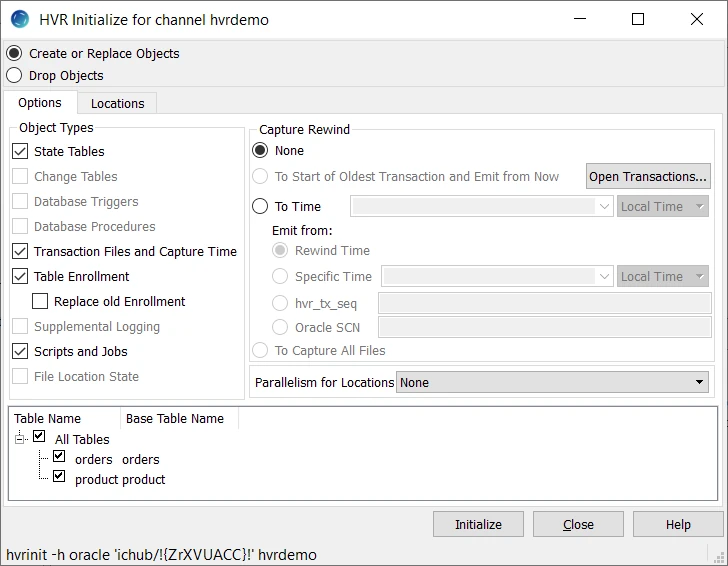
Click OK.

Click Close in the HVR Initialize dialog.
Click the Scheduler node in the navigation tree pane to view the capture and integrate jobs in the Jobs pane.
For more information about initiating replication in HVR, see section Replication Overview.
Start Scheduler
This section describes how to start the HVR Scheduler. The HVR Scheduler is a process which runs jobs defined in the catalog table HVR_JOB. This catalog table can be found in the hub database. On Unix or Linux, the HVR Scheduler runs as a daemon. On Windows, the HVR Scheduler runs as a system service.
In the navigation tree pane, right-click Scheduler ▶ Start.
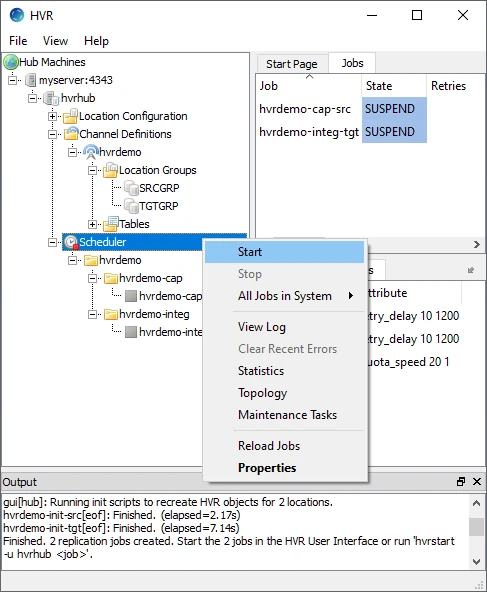
On Windows, the following steps are required to create the HVR Scheduler system service.
Click Create... in the prompt asking to create the service hvrscheduler_hvrhub.
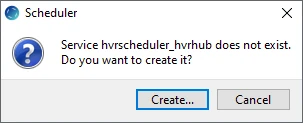
In the Create Windows Service dialog, select Local System Account ('SYSTEM') and click Create.
Start Capture Job
This section describes how to start the job for capturing changes from the source location (src). By starting the Capture job in HVR Scheduler, HVR begins capturing all changes since the moment HVR Initialize was executed. This 'capture begin moment' can be modified using option Capture Rewind available in the Advanced Options tab of the HVR Initialize dialog.
In the navigation tree pane, click Scheduler.
Start the capture job. In the Jobs pane, right-click capture job hvrdemo-cap-src ▶ Start.
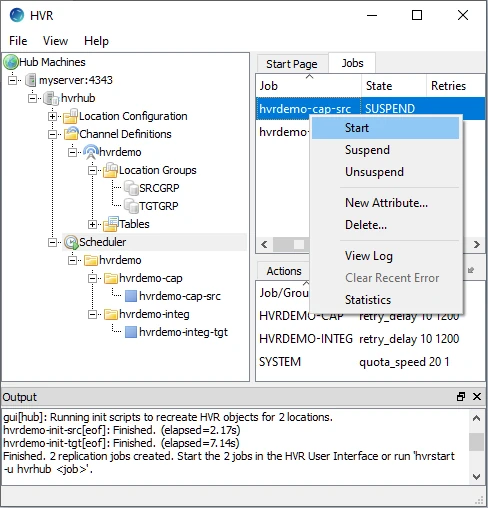
Click Yes in the Start dialog.
On starting the capture job (hvrdemo-cap-src) successfully, the status of the job changes from SUSPEND to RUNNING.
Refresh
This section describes how to perform initial load into the target database. HVR Refresh copies all existing data from the source location (src) to the target location (tgt) and optionally creates new tables and keys in the target location.
- In the navigation tree pane, right-click channel hvrdemo ▶ HVR Refresh.
- Select the table(s) that needs to be copied from the source location to the target location.
- Select Create Absent Tables in HVR Refresh dialog.
- Click Refresh.
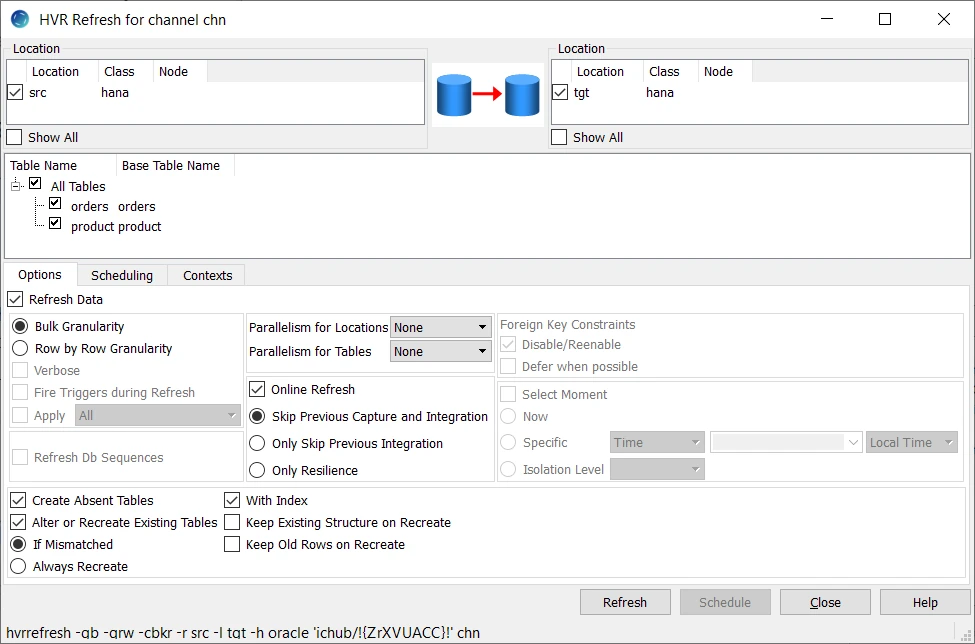
- Click Yes to begin HVR Refresh. When the refresh is completed, the Refresh Result dialog displays the total number of rows replicated from the selected tables.
- Click Close in the Refresh Result dialog and then in the HVR Refresh dialog.
Start Integrate Job
This section describes how to start the job to integrate changes into the target location (tgt).
In the navigation tree pane, click Scheduler.
Start the integrate job. In the Jobs pane, right-click integrate job hvrdemo-integ-tgt ▶ Start.
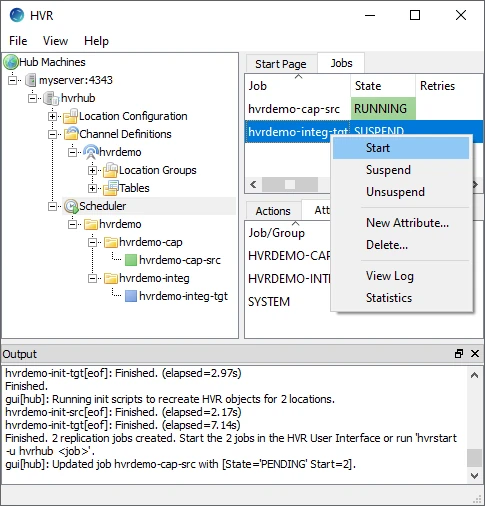
Click Yes in the Start dialog.
On starting the integrate job (hvr_demo-integ-tgt) successfully, the status of the job changes from SUSPEND to RUNNING.
Verify Replication
This section describes two methods for verifying the HVR's replication activity.
Viewing Log File
HVR creates separate log files for the hub, channel (hvrdemo), and for each replication jobs (hvrdemo-cap-src and hvrdemo-integ-tgt). These log files contain the details of the changes captured and integrated.
Replication can be verified by inspecting the channel log file.
To view the replication activity log:
In the navigation tree pane, click + next to the Scheduler.
Right-click hvrdemo ▶ View Log to view the log of both Capture and Integrate jobs.
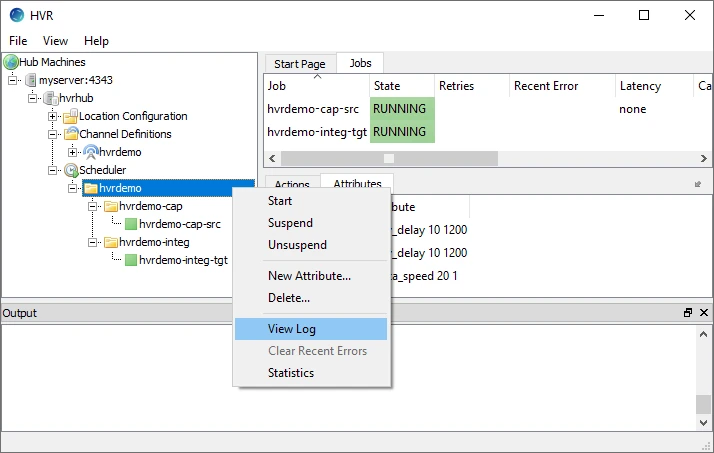
The logs for both Capture and Integrate jobs are displayed in the logs pane (Log of channel hvrdemo) at the bottom of the screen.

The directory path for the HVR log files is displayed in the log tab.
Right-clicking a particular job and selecting View Log displays logs related to that job alone.
Insert, update, or delete value(s) in the source location database. For example:
insert into dm01_product values (101, 91, 'Pencil')The output log is updated and indicates that the change is captured from the source location and integrated into the target location:

Using HVR Compare
HVR Compare allows you to verify the replication activity by comparing the data in source and target locations.
To compare the source and target locations:
Suspend the integrate job (hvrdemo-integ-tgt):
- In the navigation tree pane, click Scheduler.
- In the Jobs pane, right-click integrate job hvrdemo-integ-tgt ▶ Suspend.
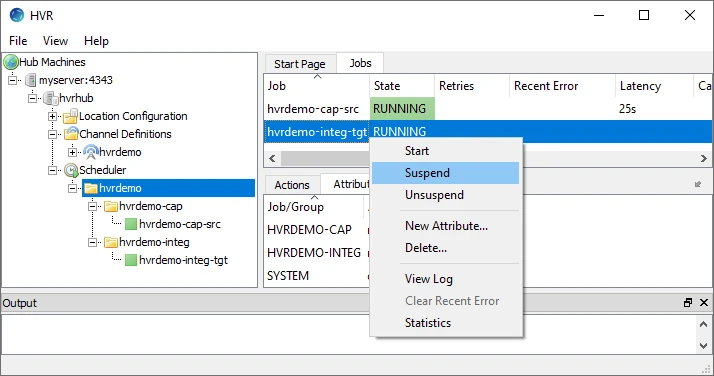
- Click Yes in the Suspend dialog.
Insert, update, or delete value(s) in the source location database. For example:
insert into sourcedb.product values (101, 91, 'Pencil');Execute HVR Compare:
- In the navigation tree pane, right-click channel hvrdemo ▶ HVR Compare.
- Select the source location (src) on the left side and the target location (tgt) on the right side.
- Select Generate Compare Event in the Scheduling tab.
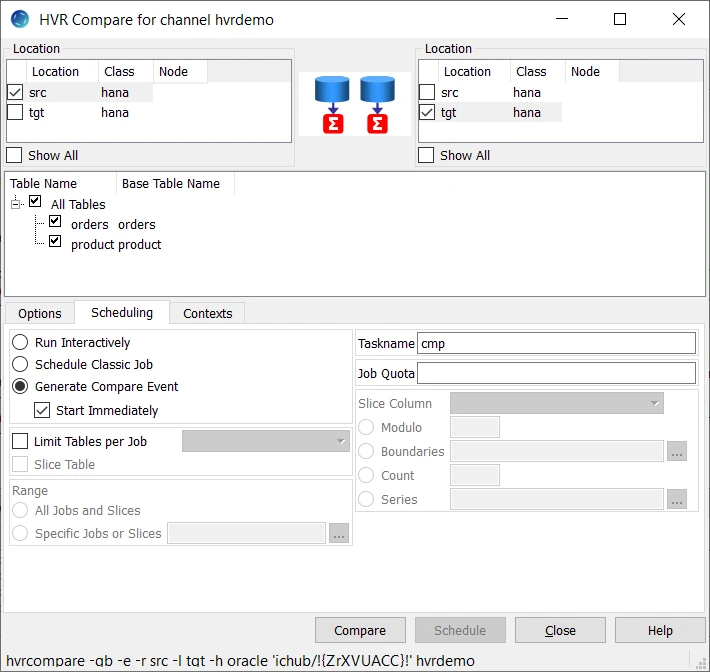
- Click Compare.
- On completion, the compare result is displayed in the web browser. If the State column displays DONE/DIFFERENT, it indicates the data in the source and target locations are not identical.

- Start Integrate Job (hvrdemo-integ-tgt), the changes made in source location (in step 2) will be integrated to the target location now.
- Execute HVR Compare again (step 3). In the compare result screen, if the State column displays DONE/IDENTICAL, it indicates the changes are replicated successfully.
